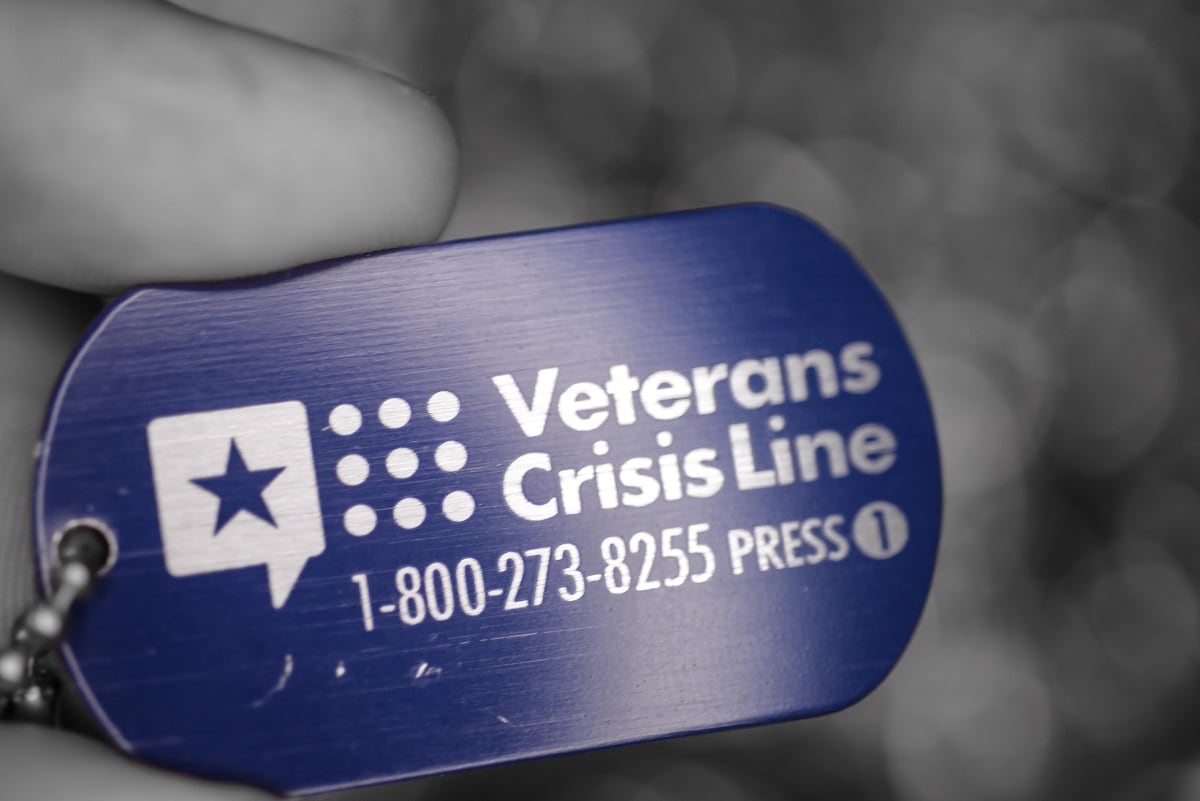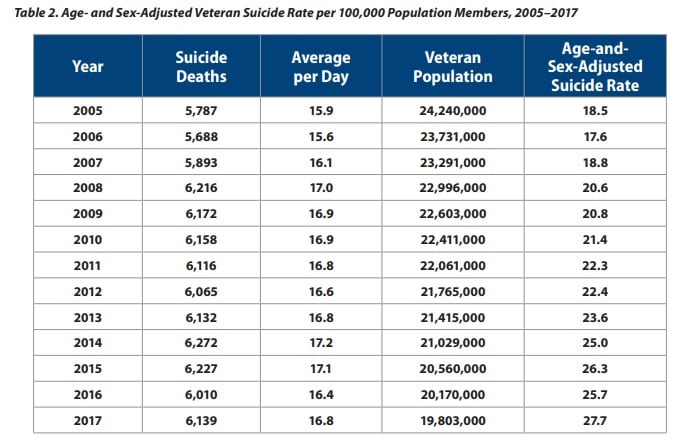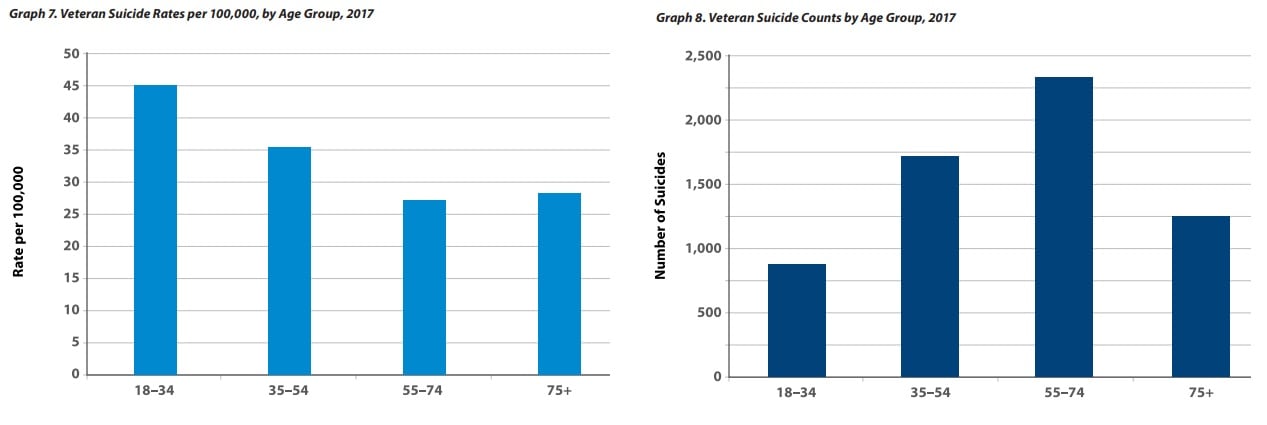Researchers this year changed a key metric in how they track veterans suicides in an effort to better explain the scope of the problem, but mental health advocates say it still doesn’t tell the full story.
In the last four years, the official government estimate on the number of veterans who die by suicide has gone from 22 a day to 17 a day in the latest Veterans Affairs report. But the rate of suicides among veterans didn’t decrease over that span. Instead, the way the figures are sorted and presented did.
Instead, outside experts note that by many markers the problem has grown even worse. The total number of suicides among veterans has increased four of the last five years on record. From 2007 to 2017, the rate of suicide among veterans jumped almost 50 percent.
Veterans are 1.5 times more likely to die by suicide than Americans who never served in the military. For female veterans, the risk factor is 2.2 times more likely.
RELATED

“Our takeaway from all this is that what we are doing is not working,” said Chanin Nuntavong, national director of veterans affairs and rehabilitation for the American Legion. “Everyone has been focused on this, but we’re not seeing results.”
Reducing veterans suicide has been the top clinical priority of VA officials for the last few years, and a major focus of executive branch and congressional leaders for at least a decade. In March, a special interagency task force established by the White House is scheduled to unveil its latest plans for that effort.
Yet the impact of that work so far has been disheartening to many advocates who had hoped to see reductions in the suicide numbers by now. Despite some positive steps and mitigating factors, real progress on the issue is still out of reach.
“In my eyes, this report tells us it’s time to do something different,” Nuntavong said. “We lost more than 60,000 veterans to suicide over 10 years. That’s ridiculous.”

A national problem
About 6,100 veterans died by suicide in 2017, the latest year for which data is available. That number stayed roughly steady over the previous decade, even as the total number of veterans in America has dropped by about 15 percent.
Over the same span, the number of suicides among all Americans rose by nearly 10,000 individuals annually, an increase of nearly 30 percent. Heather O'Beirne Kelly, director of military and veterans health policy at the American Psychological Association, said in comparison to national suicide prevention initiatives, VA’s efforts have shown some positive results.
“VA is really thinking about this and using the most up-to-date research,” she said. “But it’s a very complicated problem, it’s a multi-faceted problem. It’s tragic we can’t all figure this out more quickly.”
Department officials have repeatedly emphasized that cutting down the number of veterans suicides will require more than just government programs, noting that nearly two-thirds of those deaths are among veterans who are not using VA health services.
“We cannot do this alone,” Dr. Richard Stone, executive in charge of the Veterans Health Administration, wrote in an open letter accompanying the department’s suicide report release last month. “We call on our community partners to join us in this effort.”
The revamping of how the VA suicide data is presented was part of that approach of showing the problem is broader than just the veterans’ community.
As recently as four years ago, VA leaders were still referencing the “22 a day” statistic in regards to veterans suicide based on partial state death records data and internal estimates. After a research push in 2016, department leaders shifted that figure to “20 veterans a day” based on more reliable information, without establishing any reduction in deaths.
This year’s report now cites the veterans suicide figure as “17 a day,” removing active-duty, National Guardsmen and reservists from the larger number. State data had grouped all military together in the past. Again, VA officials are quick to point out that the new metric does not represent a decrease in veteran deaths, just a different way of presenting the information.

A veterans problem
In fact, the rate of veterans suicide has grown significantly worse in recent years. From 2006 to 2017, that figure rose ever year except for one.
“What we see is there is a specific problem with veterans and suicide,” said Rajeev Ramchand, a research fellow with the Bob Woodruff Foundation who has worked closely on the issue. “There is a younger veteran problem, there is a female veteran problem.”
Although the bulk of veteran suicides are among individuals 55 and older, that’s largely a reflection of how much of the population is from earlier generations. The rate of suicide among those older veterans is about 25 per 100,000 individuals. Among 18- to 34-year-old veterans, that figure is almost 45 per 100,000.
“As you try to bring down the numbers, you have to look at that older group because the most suicides are there,” Ramchand said. “But I think the bigger question VA has to grapple with is why that younger number keeps getting worse.”
Outreach also continues to be a major obstacle for VA prevention efforts.
While the department’s report notes that its medical centers “performed comparably or better than non-VA facilities” in most mental health treatment measures, those efforts only affect veterans who use VA for care. Currently, more than half of veterans in America do not.
RELATED

What comes next?
Part of the difficulty in analyzing the suicide data, experts agree, is the lag time it takes to collect the figures. None of the numbers in the latest report reflect any program or policy changes from the last two years.
The presidential task force on suicide prevention has promised to look for ways to speed up that information collection, in hopes of quicker reaction to community needs.
At a Capitol Hill briefing last month, Barbara Van Dahlen — executive director of task force — said other topics of focus will be better coordinating federal and state resources, increased outreach of available VA services, and discussion on lethal-means safety, to include education on firearms and veterans suicide.
Gun control has become a divisive political topic on Capitol Hill, but both Van Dahlen and VA Secretary Robert Wilkie have said they intend to engage on the issue to find a middle ground that produces safer outcomes for veterans. Cathy Barber, director of the Means Matter Campaign at the Harvard School of Public Health, said that work is overdue.
“Veterans have a higher gun ownership than the rest of the country,” she said. “That doesn’t mean they are more likely to be suicidal. But if they are, it means they are more likely to die.”
Almost 70 percent of veteran suicide deaths were as a result of firearms in 2017, compared to 53 percent of non-veteran deaths nationwide. Kelly said any serious discussion of reducing veterans suicide needs to include discussions on what factor that plays in the problem.
“VA is making inroads on the issue of gun safety and veterans, but there is a lot more work to do there,” she said. “And the veterans service organizations need to do more too.”
Ramchand said he wants to see more veterans community discussion on issues like military sexual trauma and mental health stigma to address longer-term suicide triggers, but also acknowledges that work will take significant time and cooperation with resources outside of VA.
But he said that doesn’t mean that VA can simply point to national suicide numbers as an excuse for its problems.
“Yes, we’re seeing the numbers up in society as a whole,” Ramchand said. “But there is still something unique putting veterans at risk.”
Veterans experiencing a mental health emergency can contact the Veteran Crisis Line at 1-800-273-8255 and select option 1 for a VA staffer. Veterans, troops or their family members can also text 838255 or visit VeteransCrisisLine.net for assistance.
Leo covers Congress, Veterans Affairs and the White House for Military Times. He has covered Washington, D.C. since 2004, focusing on military personnel and veterans policies. His work has earned numerous honors, including a 2009 Polk award, a 2010 National Headliner Award, the IAVA Leadership in Journalism award and the VFW News Media award.




